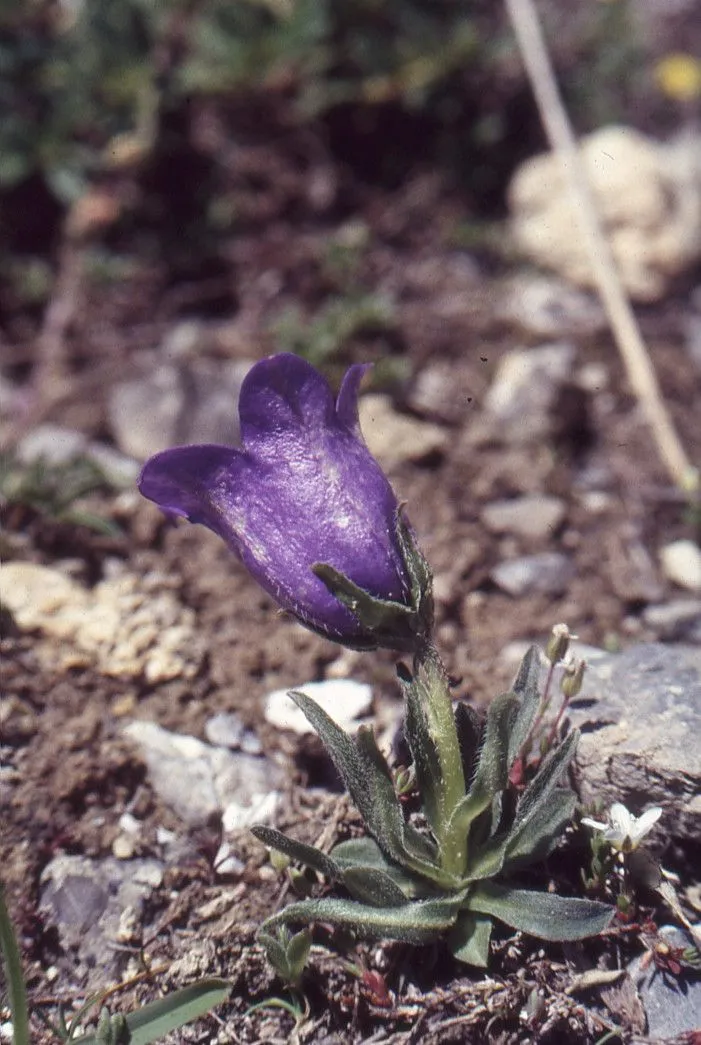
Author: All.
Bibliography: Auct. Syn. Meth. Stirp. Hort. Regii Taur.: 11 (1773)
Year: 1773
Status: accepted
Rank: species
Genus: Campanula
Vegetable: False
Observations: SW. Alps
The Provence bellflower, scientifically known as Campanula alpestris, stands as a delicate and enchanting representative of the Campanulaceae family. This charming plant, distinguished by its bell-shaped blooms, is indigenous to the Southwestern Alps, where it thrives in the cool, elevated climates and rugged terrains.
First described thoroughly in the seminal botanical work “Auctarium Synodontario Methodo Stirpium Horti Regii Taurinensis” in 1773, the Provence bellflower was classified by the renowned botanist Allioni. His meticulous observation and classification have allowed subsequent botanists and horticulturists to further explore and appreciate this alpine treasure.
The Provence bellflower is characterized by its exquisite bell-shaped flowers, which typically display shades of blue to violet. This coloring is not only visually appealing but also serves as an attractive contrast against the stark, often rocky Alpine landscapes. The flowers bloom in clusters, creating a picturesque scene that resonates with the natural charm and beauty of the Alps.
This plant thrives in alpine meadows and rocky substrates, where it enjoys a blend of sunlight and cool, moist conditions. It’s adapted to survive in challenging environments, often enduring cold temperatures and high altitudes. Despite these harsh conditions, the Provence bellflower manages to maintain its delicate appearance and vibrant blooms, a testament to its hardiness and resilience.
In the world of gardening, the Provence bellflower is often cherished for its ornamental value. Its ability to bloom in tough conditions makes it a favorite among gardeners looking to add a touch of alpine beauty to rock gardens and naturalistic plantings. It is relatively easy to care for, provided it is planted in well-drained soil and given adequate moisture, mimicking its natural alpine habitat.
The Provence bellflower not only enhances the aesthetic appeal of alpine and rock gardens but also supports local ecosystems. The blossoms attract various pollinators, including bees and butterflies, playing a crucial role in sustaining the biodiversity of the regions it inhabits.
In essence, Campanula alpestris or the Provence bellflower is a botanical gem that exemplifies the splendor and resilience of alpine flora. Its historical significance, ecological importance, and ornamental beauty make it a plant worth celebrating and preserving.
Swe: provenceklocka
En: Provence Bellflower
Nl: Allioni’s Klokje
Fi: Alppikello
Fr: Campanule alpestre, Campanule d’Allioni, Campanule des Alpes
De: Allionis Glockenblume
Is: Seyruklukka
It: Campanula occidentale, Campanula di Allioni
Sv: Provenceklocka
: Provence bellflower
© copyright of the Board of Trustees of the Royal Botanic Gardens, Kew.
© copyright of the Board of Trustees of the Royal Botanic Gardens, Kew.
Taken Jul 19, 2021 by Dell’Erba Laura (cc-by-sa)
Taken Jun 26, 2019 by yves dieudonné (cc-by-sa)
Taken Dec 23, 2021 by Frédéric Loyez (cc-by-sa)
Taken Jul 4, 2020 by Snježana Kocmanić-Paravac (cc-by-sa)
Taken Jul 10, 2006 by Reinhard Bachmann (cc-by-sa)
Taken Jul 2, 2004 by Tela Botanica − Liliane ROUBAUDI (cc-by-sa)
Taken Jul 26, 2020 by Denis Bastianelli (cc-by-sa)
Taken Jul 16, 2021 by Daniel Barthelemy (cc-by-sa)
Taken Jul 16, 2021 by Daniel Barthelemy (cc-by-sa)
Taken Jul 16, 2021 by Daniel Barthelemy (cc-by-sa)
Taken Aug 3, 2022 by Anatas (cc-by-sa)
Taken Jun 20, 2000 by Tela Botanica − Liliane ROUBAUDI (cc-by-sa)
Taken Jul 21, 2021 by huy HO (cc-by-sa)
Taken Jul 2, 2004 by Tela Botanica − Liliane ROUBAUDI (cc-by-sa)
Taken Jul 2, 2004 by Tela Botanica − Liliane ROUBAUDI (cc-by-sa)
Taken Jul 15, 2003 by Photoflora – Benoit BOCK (©)
Taken Aug 15, 2013 by Photoflora – Jean-Luc TASSET (©)
Taken Jan 1, 1970 by Photoflora – L’Abbé COSTE (©)
Taken Jul 15, 2012 by Photoflora – Benoit BOCK (©)
Taken Jul 7, 2014 by Tela Botanica − Liliane Roubaudi (cc-by-sa)
Taken Jul 15, 2003 by Photoflora – Benoit BOCK (©)
Bloom months: [‘jul’, ‘aug’]
Family: Myrtaceae Author: (F.Muell.) K.D.Hill & L.A.S.Johnson Bibliography: Telopea 6: 402 (1995) Year: 1995 Status:…
Family: Rubiaceae Author: Pierre ex A.Froehner Bibliography: Notizbl. Bot. Gart. Berlin-Dahlem 1: 237 (1897) Year:…
Family: Sapindaceae Author: Koidz. Bibliography: J. Coll. Sci. Imp. Univ. Tokyo 32(1): 38 (1911) Year:…
Family: Asteraceae Author: A.Gray Bibliography: Pacif. Railr. Rep.: 107 (1857) Year: 1857 Status: accepted Rank:…
Family: Fabaceae Author: Medik. Bibliography: Vorles. Churpfälz. Phys.-Ökon. Ges. 2: 398 (1787) Year: 1787 Status:…
Family: Aspleniaceae Author: (Cav.) Alston Bibliography: Bull. Misc. Inform. Kew 1932: 309 (1932) Year: 1932…